This post was originally published on March 26, 2015.
Written by Kate Grimes
Confession: I haven’t mowed the front lawn in a while, and with the warm days of late winter, it’s starting to get a bit “shaggy.” The front yard had become a nagging and guilt-inducing chore when its sad brownish hue burst into a soft pink glow just the other day.
It was the Henbit (Lamium ssp.), rosy pink and everywhere. The Henbit convinced me to take a closer look, and upon inspection, I found an incredible diversity of plant species in what before had been a green blur.
The grasses were just coming out of dormancy, and there were sweet little flowers everywhere; the tiny yellow blooms of horse herb (Calyptocarpus vialis) and the tall white inflorescences of shepherd’s purse (Capsella bursa-pastoris), the stellate blooms of chickweed (Stellaria media) and the tall shocks of the purple and pink spiderworts (Tradescantia ssp.).
I was so glad I’d failed to mow… this was incredible! And as it turned out, just about everything growing in the yard I could identify had long culinary and medicinal use histories. Who knew there was a salad bar out there?
Most of the species I identified were also classified as invasive weeds, mainly native to Europe, and that got me thinking about the relativity of the term “weed.” The descendants of those who initially brought these plants across the Atlantic are those people (“us”) classifying these plants as objectionable.
It’s quite possible the seeds of many European plant “invaders” were unwittingly transported to the New World, but, seeing how useful these plants have been to humans for hundreds of years, some must have been intentionally smuggled.
So my plan became this: eat the lawn, don’t mow it! I had heard of people blending fresh herbs with juice as a smoothie or drying them to make tea. I opted to wilt the herbs in a bit of olive oil with a pinch of salt and serve them over rice or some other grain.
I gathered a handful of Henbit, cleavers, and shepherd’s purses and wilted them in my cast iron skillet on medium heat for only three to five minutes. It was mild but not unpleasant and filled some primal need in me to hearken to the new season by ingestion!
The most common henbit species (Lamium amplexicaule) is in the mint family. Like many of the plants we call weeds, Henbit is a non-native and can aggressively fill large areas and often undesirable areas like cracks in the pavement; I came across a common name, “Driveway Mint,” which seemed particularly apt.
It is an annual herb, but it readily reseeds. As a member of the mint family, Henbit acts as a gentle digestive aid and has also been historically used as an astringent and vulnerary or wound-healing medicine (Tilford, Gregory L. Edible and Medicinal Plants of the West. Missoula: Mountain Press Publishing Company, 1997).
You Might Also Like: https://thegrownetwork.com/weed-garden-henbit-deadnettle/
Henbit is a mild herb that tastes good and is active in the body. It is also a welcome sign of spring. As one of the first plants to bloom in the late days of winter, Henbit is also an early and much-needed nectar source for honeybees and other pollinators(http://www.ediblewildfood.com/henbit.aspx).
Last night, I took the dog for a walk, and when I got home, I realized my ankles and her flanks were covered in long strands of cleavers (Gallium aparine). I had been previously acquainted with this close cousin to Velcro, having known it as “Stickywilly.” Never was there a more appropriate name; the tall stems of cleavers have intermittent whorls of long thin leaves and are wholly covered with tiny hooked hairs that attach themselves famously well to any surface.
You Might Also Like: https://thegrownetwork.com/use-cleavers/
Cleavers are in the coffee family, and the seeds are mildly caffeinated (Wood, Matthew. The Earthwise Herbal: A Complete Guide to Old World Medicinal Plants. Berkeley: North Atlantic Books, 2008). I have read of people making a “coffee” from roasted and ground seeds. My interest was piqued by herbalist Nicholas Culpeper’s proclamation in his 1653 Complete Herbal, “(Cleavers) is a good remedy in the spring… to keep the body in good health, and fitting it for that change of season that is coming,” and in fact, modern herbalists still taut this herb’s ability to stimulate and tone the lymphatic system, which facilitates filtration and defense against pathogens in the body.
The identity of the shepherd’s purse (Capsella bursa-pastoris) was not immediately apparent to me, and I found it difficult to describe this pervasive and oh-so-familiar inhabitant of urban greenspaces. I finally identified it by its fleshy cordate leaves, which inspired the name shepherd’s purse, a personal accouterment once more universally identifiable.
Shepherd’s purse is in the cabbage family and thus a close cousin to the mustards, and it certainly does have a peppery bite that I found rather delicious! I noticed that the neighborhood grackles did, too! A flock seemed to be constantly grazing where the plants grow tallest. I casually noted this and found that chickens graze on shepherd’s purses have been known to lay eggs with darker yolks and more robust flavor (http://www.botanical.com/botanical/mgmh/s/shephe47.html).
It has been known to unpleasantly taint the milk of dairy cows. All of this seemed to point toward some powerful medicinal properties of the plant, and indeed, Shepherd’s Purse is a strong styptic and hemostatic, clotting bleeding in external and internal wounds. A dried tea is ingested, or a fresh poultice is applied (http://www.botanical.com/botanical/mgmh/s/shephe47.html).
Quite by happenstance, I came across a reference to a Japanese festival called “Nanakusa-No-Seku,” or the Festival of the Seven Herbs. Traditionally, one makes rice gruel on January 7 and mixes it with seven early spring field herbs. The herb catalog appears flexible, but shepherd’s purse and chickweed (Stellaria media) were commonly included. The spirit of the festival is that of welcoming spring and setting an intention of good health for the coming year (http://www.essenceofjapan.net/?portfolio=nanakusa-no-sekku-festival-of-seven-herbs%E3%80%81%E4%B8%83%E8%8D%89%E3%81%AE%E7%AF%80%E5%8F%A5).
The Japanese have been eating “Front Yard” Spring Tonics for millennia! So, though my inclination may not be novel, it is perhaps natural to want to grab a handful of the front lawn and eat it. The act represents a physiological need for the nutrients of raw fresh greens after winter’s scarcity of such things and as a symbolic nod to winter’s passing and spring’s arrival.












COMMENTS(10)
Love the title. Unfortunately I will never see such lovely things in my yard, being married to someone who constantly seeks the perfect lawn – whatever chemicals it takes.
We inner city street gangers admire you rural folk who live and love in the country.
Pictures next to each weed (with the name bolded) would have been nice so we can learn to identify them for ourselves.
A simple copy/paste to your browser pops up various articles, keeps the writer from having more work, and keeps your own brain active, but beware…this takes up more of your time as you come across more articles you have to read!
Good for you. We’ve found that every “weed” in our yard is useful for something. Better than 90% have a medicinal use. We’ve learned to leave the unidentified ones until we learn what it is and it’s useful. The one useless plant we HAVE gotten rid of is lawn grass.
I love that, Henry. I’ve heard people say a “weed” is just a plant you haven’t found a use for, yet.
Yes, I am encouraging the horse herb, hen bit, chickweed, and clover, hoping the grass gets crowded out!
Love the way this article was written! Great! Pictures of each mentioned weed would have been even better. Maybe next article we could have “identify your weed”!
I’m agreeing that finding out what they look like is too important to just guess on. Pics and descriptions for people unformilure would have been good.
I once had the outstanding opportunity to sit at Peter Caddy’s feet and ask him how to define the word “weed”. He said, “A weed is simply a plant in the wrong place. Nothing more.”
Ever since, I have had a different perspective on “weeds”. Here, it may be a “weed”. Over there, it’s an herb, or any number of other things. Everything changes according to your location and the location of the object at the moment of observation.